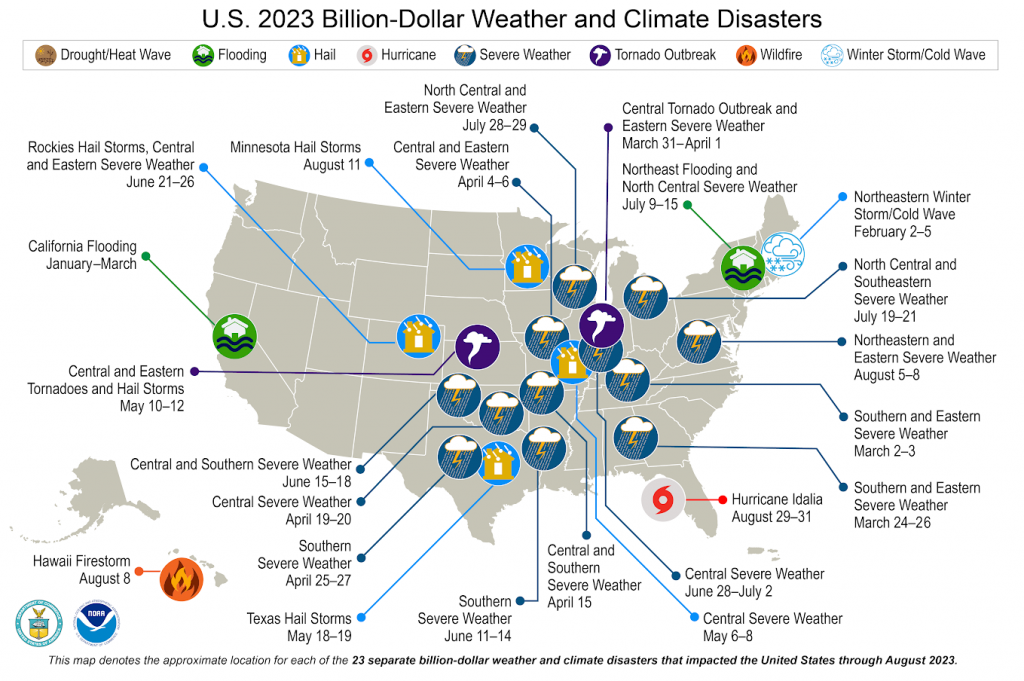 Rarely, do we get a glimpse into the future. Sometimes, that’s a good thing, but for certain circumstances, who wouldn’t welcome the chance to discover misfortune heading our way so we can prepare for it? Then there’s the question of would we do anything about it, if possible?
Rarely, do we get a glimpse into the future. Sometimes, that’s a good thing, but for certain circumstances, who wouldn’t welcome the chance to discover misfortune heading our way so we can prepare for it? Then there’s the question of would we do anything about it, if possible?
The word on the street says we might get to taste-test changes to our way of life in the 2030s in 2024. If we’re honest though, 2023 already started giving us a picture of life beyond the 1.5°C global temperature increase threshold set by the Paris Agreement, didn’t it? Will the experiences of the hottest year on record (2023) and a year that might be just as hot or hotter (2024) be enough to jar into action those who still ignore or deny climate change? And if so, can the world’s building stock reap speedier improvements for a less carbon-spewing industry? If not, what will it take? Another uptick in human suffering due to catastrophic weather conditions? Financial concerns?
We’re just warming up–to the effects of climate change.
In late 2023, Britain’s Met Office announced the potential for 2024 to see the global average temperature temporarily breach the Paris Agreement’s 1.5°C threshold. The prediction doesn’t come out of the blue, though. The European Union’s Copernicus Climate Change Service (C3S) claimed 2023 as possibly the warmest year in the last 100,000 years, ranking about 1.48°C warmer than the pre-industrial period (1850-1900). For the first time, all 365 days of a year were more than 1°C over pre-industrial years.
Temperature records in 2023 were a team effort.
Is this potential busting of the Paris Agreement threshold in the coming year a temporary fluke? Temporary, yes, for now–a fluke, no. The natural El Niño climate pattern we’re experiencing warms ocean surface temperatures to add a boost of heat on top of the warming caused by human activities such as burning coal, oil, gas, and emitting high levels of power generation–a one-two punch.
So, El Niño is not acting alone in threatening the threshold–especially since, despite targeted CO2 reductions across various sectors, emissions reached record levels in 2023. In fact, the concentration of CO2 in the atmosphere rose to 419 parts per million, the highest recorded level the planet has seen. So, what we have is the natural (El Niño) acting upon the (quite frustrating) unnatural. That, folks, leads to extreme outcomes. When El Niño eventually fizzles out, the average global temperature will drop back below the threshold and continue on the path to breaching it in the 2030s.
Are we enjoying this glimpse of a warmer future?
Bearing in mind that 2024 could be warmer than 2023, what evidence did we see in 2023 that suggests crossing 1.5°C on a more permanent basis won’t be a good time? Of note, natural disasters have always occurred, but the heat generated by human-caused global warming ups their strength, frequency, and catastrophic effects.
Let’s look at some of the consequences of climate change over this past year:
- Wildfires in Canada happen all the time. Only, they went wilder than usual last summer delivering historic forest destruction while affecting air quality in many US states. According to analysis by World Weather Attribution group, the burning of fossil fuels made the fires 50% more intense.
- Maui wildfires in Hawaii led to the thorough burning of Lahaina and 97 deaths.
- Record-high temperatures on the surface of the Mediterranean sea bleached coral and killed fish en masse.
- Florida’s Manatee Bay hit record hot tub temperatures causing anoxia–where oxygen starts leaving the water–despite how much sea life needs it.
- Flooding killed over 6,000 people in Libya.
- 77,000 hectares of land burned in the largest fire in Greece’s history.
- A cyclone managed to cause deadly flooding in 60 Brazilian cities.
- China, too, saw extreme flooding due to a typhoon on steroids.
We’re ‘there’, folks. The toll taken on human beings, wildlife, and the planet’s ecology at large is no longer in the future, but now–with more and worse to come if we don’t take swifter and greater strides to lower our carbon footprint.
As professionals in the building sector with a responsibility to lower the carbon footprint of our industry, we have our work cut out for us. In many cases, creating the technology to lower building operation and construction emissions isn’t the issue. Much of that tech is there. We know because we’ve designed energy recovery solutions for the sector’s HVAC operations. Then there is geothermal energy, carbon capture, solar solutions … the list goes on. We just need more folks onboard to invest in, implement, and use it.
As purveyors of energy-efficient HVAC systems, we’ve seen the satisfaction that comes from installing DOAS that runs via recovered energy, improves IAQ, keeps occupants comfy, and lowers a structure’s carbon footprint. We’ve met folks who care about the human and ecological suffering we face and want to do something about it, others who are about their indoor health and comfort.
That’s far from everyone though. Some people need a different sort of incentive….
Think Green … in terms of money.
According to the World Economic Forum, studies using a methodology known as Extreme Event Attribution (EEA), have estimated,
- “…the cost of the extreme weather damages from 2000 to 2019 averages around $143 billion, which breaks down to around $16.3 million per hour.”
- “The global cost of climate change damage is estimated to be between $1.7 trillion and $3.1 trillion per year by 2050.” (Damages to human health, infrastructure, property, and agriculture are included.)
EEA methodology connects the greenhouse gas emissions from human activity and the changes in weather events. Those results are compared to socio-economic costs from those extreme weather events to see how much of the cost is human-related.
But let’s look at the financial costs to the United States alone. From January through August 2023, we endured what the NOAA calls the “all-time highest number of billion-dollar disasters” in one year.
- severe weather events – 18
- major flooding events – 2
- hurricane Idalia
- a wildfire event
- a winter storm event
According to an NOAA report, “These events caused 253 direct and indirect fatalities and produced more than $57.6 billion in damages (Consumer Price Index (CPI)-adjusted).”
A map of the U.S. plotted with 23 weather and climate disasters, each costing $1 billion or more, which occurred between January and August. Image: NOAA/NCEI
Says Climate.gov regarding the influence of human-caused climate change, “There is an increased need to focus on where we build, how we build, and investing in infrastructure updates that are designed for a 21st-century climate.”
Obviously, a comparison between what it costs to prevent worse damage by hitting net-zero globally by 2050 and the disaster-related costs of not doing so is not so simple. In the short-term, the financial losses of flooding, drought, destruction, and loss of life are a huge hit. However, the costs incurred by transitioning from fossil fuels swiftly and effectively incur long-term investments and hefty upfront costs. Then again, every fraction of a degree increase in average global temperature heightens the destructive capabilities of weather disasters. Economic consequences are escalating and will continue to do so. Is it too late to find a balance? Do we suck up the short-term for the long? We’ll leave that debate to the economists.
Without any control over the answers, at BPE we figure the best we can do is keep our noses to the grinder by educating our consumers on solutions we can offer within our sector: healthy indoor air, comfort, savings, and stewardship of the planet.
How do you educate your clients? What makes them tick? We’ve found getting to know what’s most important to them in choosing HVAC/DOAS systems is key for selling and implementing energy-efficient, energy-recovery systems. Are they focused on health? The wellbeing of the planet? Saving money?
Having a product you’re proud to present or represent helps, as does knowing what is important to you as a sales rep, contractor, engineer, architect, or HVAC professional. Due to today’s high stakes, that doesn’t seem as simple as it used to be either. So, if BPE can help answer questions you or your clients may have about energy recovery, HVAC design, and superior ventilation practices, please don’t hesitate to give us a call because as building professionals, we’re in this together. Not to mention, helping people live better lives is what’s important to us!
For a deep-dive into the effects of climate change and humanity’s role in it, the following resources offer a serious reality check.
Fifth National Climate Assessment
https://nca2023.globalchange.gov/
World Weather Attribution
https://www.worldweatherattribution.org/
CITATIONS
Reuters. (2024, January 9). 2023 was the world’s hottest year on record, EU scientists confirm. Reuters. https://www.reuters.com/business/environment/2023-was-worlds-hottest-year-record-eu-scientists-confirm-2024-01-09
Reuters. (2023, December 8). Global warming threshold could be hit temporarily in 2024 – UK’s Met Office. Reuters. https://www.reuters.com/business/environment/global-warming-threshold-could-be-hit-temporarily-2024-uks-met-office-2023-12-08
Reuters. (2023, August 22). Climate change made eastern Canada wildfires twice as likely, scientists say. Reuters. https://www.reuters.com/business/environment/climate-change-made-eastern-canada-wildfires-twice-likely-scientists-say-2023-08-22/
World Economic Forum. (2023, October). Climate loss and damage cost $16 million per hour. World Economic Forum. https://www.weforum.org/agenda/2023/10/climate-loss-and-damage-cost-16-million-per-hour/
National Oceanic and Atmospheric Administration. (n.d.). U.S. saw its 9th warmest August on record. NOAA. https://www.noaa.gov/news/us-saw-its-9th-warmest-august-on-record

